
THE EDMUND
FITZGERALD
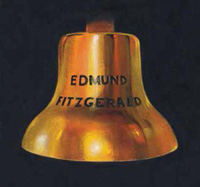
Song of the Bell
BY KATHY-JO WARGIN & ILLUSTRATED BY GIJSBERT VAN FRANKENHUYZEN
A UTHORS N OTE
It is with sincere appreciation and gratitude that I thank Tom Farnquist, Executive Director of the Great Lakes Shipwreck Historical Society, for all of his guidance, input, and advice with this manuscript. This book could not have been done without your help. I would also like to thank all others who helped along the way, including the staff at the Petoskey Library, the staff at the Shipwreck Museum at Whitefish Point, my eight-year old son, Jake, for reading the manuscript and offering perspective through the eyes of a young reader, and to my husband, Ed Wargin, who helped every step of the way. Thank you.
Kathy-jo
I LLUSTRATORS N OTE
I want to thank the staff at both the Valley Camp Museum Ship in Sault St. Marie, Michigan, and the Willis B. Boyer Museum Ship in Toledo, Ohio, for letting me roam the ships. All of your helpful information became a valuable resource for the paintings in this book.
Many thanks go to Tom Farnquist and to the staff of the Shipwreck Coast Museum at Whitefish Point. The time and knowledge you shared with me was crucial to my research into and visual interpretation of this story.
Gijsbert
Text Copyright 2003 Kathy-jo Wargin
Illustration Copyright 2003 Gijsbert van Frankenhuyzen
All rights reserved. No part of this book may be reproduced in any manner without the express written consent of the publisher, except in the case of brief excerpts in critical reviews and articles. All inquiries should be addressed to:
Sleeping Bear Press
315 E. Eisenhower Parkway, Ste. 200
Ann Arbor, MI 48108
www.sleepingbearpress.com
2003 Sleeping Bear Press is an imprint of Gale.
Printed and bound in China.
10 9 8 7 6 5 4 3
Library of Congress Cataloging-in-Publication Data
Wargin, Kathy-Jo.
The Edmund Fitzgerald : song of the bell / written by Kathy-Jo Wargin;
illustrated by Gijsbert van Frankenhuyzen.
p. cm.
Summary: Describes the voyage and sinking of the giant transport ship,
the Edmund Fitzgerald, which was caught in a raging storm while crossing
Lake Superior in November, 1975.
ISBN 978-1-58536-126-7
1. Edmund Fitzgerald (Ship)Juvenile literature. 2. Shipwrecks-Superior,
Lake-Juvenile literature. [1. Edmund Fitzgerald (Ship) 2. Shipwrecks.]
I. Frankenhuyzen, Gijsbert van, ill. II. Title.
G530.E26 W37 2003
917.749043dc222003013155
L ONG, LONG AGO, DEEP GLACIERS LAY COLD AND HARD UPON THE LAND . O VER TIME, THESE HUGE WALLS OF ICE BEGAN TO THAW AND MOVE AWAY, SCRAPING DEEP BASINS INTO THE EARTH. A S THEY PUSHED ALONG, EACH LARGE DEPRESSION FILLED WITH WATER FROM THE MELTING ICE, GIVING BIRTH TO A LARGE AND POWERFUL BODY OF FRESH WATER WE NOW CALL THE G REAT L AKES.
I t was a warm Sunday afternoon on November 9, 1975. This was a time when people wore bell-bottom pants and platform shoes, and were learning a dance called the Hustle. Gerald R. Ford was president of the United States, a loaf of bread cost about 38 cents, and the waterways of the Great Lakes were filled with boats carrying coal, salt, lumber, and iron ore.
On this day, a group of sailors left port out of the Duluth-Superior Harbor in Superior, Wisconsin. That morning, the Edmund Fitzgerald had been loaded with 26 thousand tons of taconite pellets, which are tiny balls made from refined iron ore. This ore was to be taken to Zug Island in the Detroit River and used to build cars. This was the job of the men aboard the Edmund Fitzgerald, to safely transport taconite from the Iron Range of Minnesota to ports across the Great Lakes.
The bell rings forever where heroes are found, for the soul of the sailor is held in its sound.
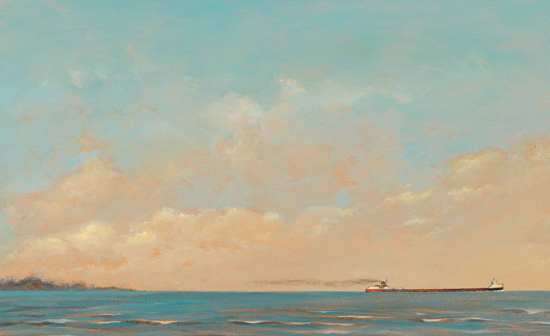
At 729 feet long, the Edmund Fitzgerald was the largest ship on the Great Lakes from the time it was launched in 1958 until larger ships came along in 1971. Through all its days, it was called the Pride of the American Flag, and was the finest cargo ship on the Great Lakes. Because of this, only the best sailors in the fleet were offered the chance to work on board.
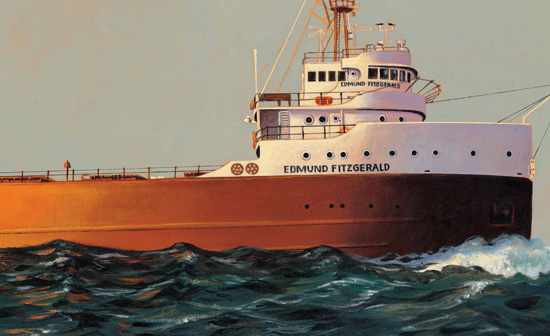
The ship plowed its way northeast in a slow, steady way. Captain Gerald Ernest McSorley knew that bad weather was blowing in because the weather bureau had issued a gale warning earlier that day. It was now early evening and he knew to pay close attention to the weather as they made their journey. Lake Superior is the deepest and largest of the Great Lakes, and its vast size could be troublesome when storms blow in.
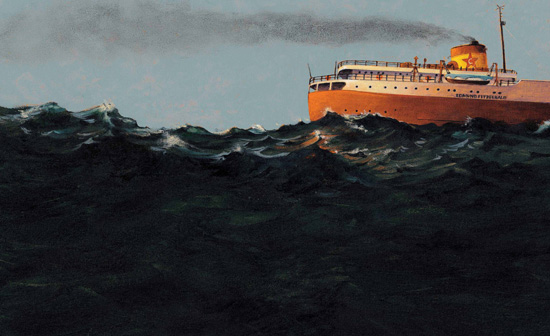
But at the moment, this did not seem to bother Captain McSorley or his crew. They had experience with the wild storms of Lake Superior, and they knew their jobs well. So as the ship pushed on, the men kept busy with their duties. John Simmons, the wheelsman, steered the ship, while Nolan Church, the porter, helped serve meals in the ships galley. John McCarthy, the first mate, assisted the captain while the cook polished the huge bell that sat on top of the pilothouse.
Every job on the ship was important, but it was usually a tradition for the cook to take care of the 200-pound bronze bell. The bell was buffed and shined to a beautiful golden luster, as if it were a brilliant crown.

The bell rang every four hours to announce a change in the watch. Other times, it rang to warn of fog. And when it did, it always rang with a rich and lovely sound, reaching deep into the souls of the crewmen on board.
The soul of each sailor sang out in the chime of the beautiful bell as it rang to keep time.
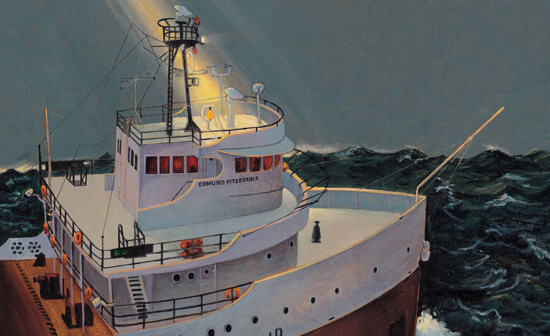
By nightfall, the Edmund Fitzgerald had traveled many miles. Captain McSorley knew that another ship carrying taconite, the Arthur M. Anderson, was traveling behind him. It had left port out of Two Harbors, Minnesota, and was heading to Gary, Indiana.
The two ships pushed on through midnight and into the early hours of morning.
As they did, the waves grew around them.

Black water whipped into a mass of confusion, striking out at the ship. The freshwater sea roared, and it was nearly impossible to tell the rain and snow from the tops of the waves.
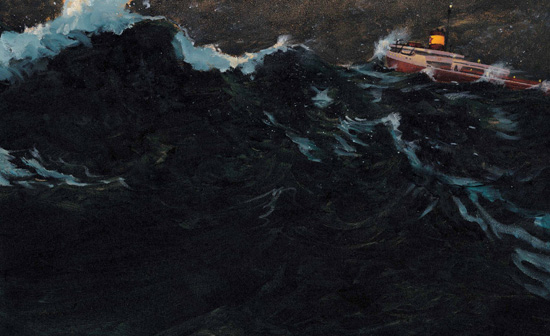
But even as the storm raged around them, the 29 men aboard the Edmund Fitzgerald continued with their jobs, watchful and alert. And all the while, the bell remained steadfast as the wind blew all around it.
Next page















